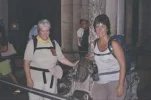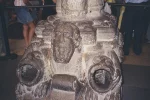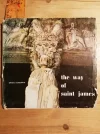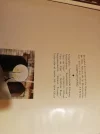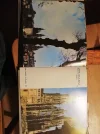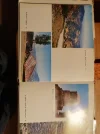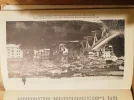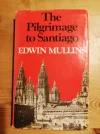I walked the Frances from Saint Jean in August, 1984. Some memories are a bit vague and I have no idea how I found out pre internet days about the Way of St James, as I knew it.
If there was any pilgrim infrastructure other than churches I didn't see any, But I was wild camping so wouldn't have noticed Hostels or Albergues although I did stay in a campsite in Saint Jean.
I started my pilgrimage by attending church, but the old woman who ran the pilgrim office from her house, refused to give me a credential because I hadn't walked from home and no letter from my priest, and shooed me out telling me I couldn't walk HER route. In my confusion I set off in the wrong direction only realising my mistake at nightfall,
There were lots of Basque flags and ETA separatist graffiti and I had to evacuate a train on the way to Saint Jean because of a bomb threat and stopped by a mobile military patrol somewhere towards Roncesvalles who gave me a bar of chocolate.
Many villages seemed rather run down and deserted. Apart from in larger towns I don't remember there being bars or cafes but this may have been because I couldn't afford them. Although I do remember being in a bar with a cobbled floor that was part of a cow barn, where the cows were munching happily on hay on the other side of a low wood partition which they occasionally stuck their heads over mooing loudly.
Whilst I rested by and occasionally in village water fountains to escape the heat, the locals would bring out their kettles and pans to fill, presumably they had no water in their houses, I also remember seeing the women washing clothes in outdoor communal sinks
I don't remember any supermarkets, and shops were few and far between and often shut. Several times I would be directed to a house, where the shop was just a spare room with the barest essentials, sometimes large hams and sausages were hanging from the ceiling, Buying small quantities of identifiable food suitable for a camping meal wasn't easy. I once downed half bottle of juice as I was so thirsty, after not finding any water, and nearly killed myself as it was pure concentrated lemon juice.
Once I had to eat in a rather posh restaurant as I hadn't found any shops that day, but the owner refused payment, some shops wouldn't accept money either and occasionally passers by would force money on me. I was invited to a local bull run and several religious services by the friendly locals who would wave or shake hands as I passed.
However wild farm dogs were not so friendly, rushing towards me ferociously, luckily mostly on chains. I soon learnt to carry a stick..
I don't remember any arrows and certainly no large markers, I think the markers were yellow stripes like on the French GR routes, but whatever they were, I do remember they were well hidden on the yellow rocks or yellow stone houses, in a landscape of yellow stubble fields and yellow dirt tracks with yellow post boxes and yellow mail vans and yellow dogs.
I didn't carry a guide book, but a Michelin road map of Spain and some tourist leaflets and navigated by instinct and asking directions in towns,
I also carried or wore no technical gear: Just cut off jeans, desert boots, sports socks and cotton t shirts and a light tarp which doubled as a poncho, a goatskin water bottle, and a portable sundial which I bought in St Jean I think.
I probably sent a few postcards home to let them know where I was or at least had been. That was keeping in touch back then.
Maybe it was because I was camping, but I saw no other Pilgrims or anyone else walking in the countryside apart from an occasional farmer. Unfortunately I abandoned half way near Leon due to the unbearable heat, being used to the cold wet mountains of the Scottish highlands.
Things have certainly changed a lot from what I've read here but I'm glad I experienced it before the infrastructure, commerce and crowds, the technical gear and internet gadgets although I am looking forward to seeing the changes either in 2020 or 2021,





